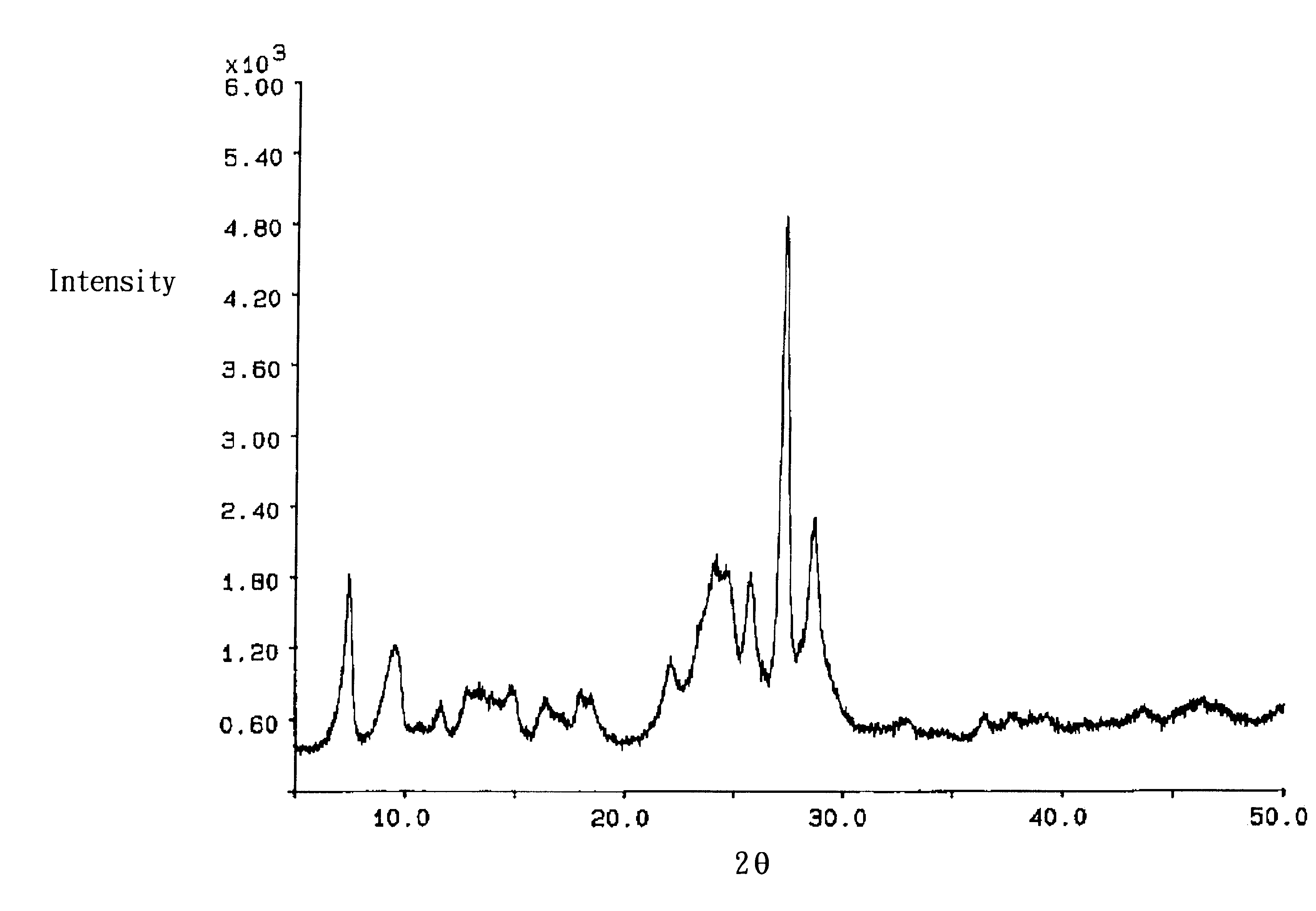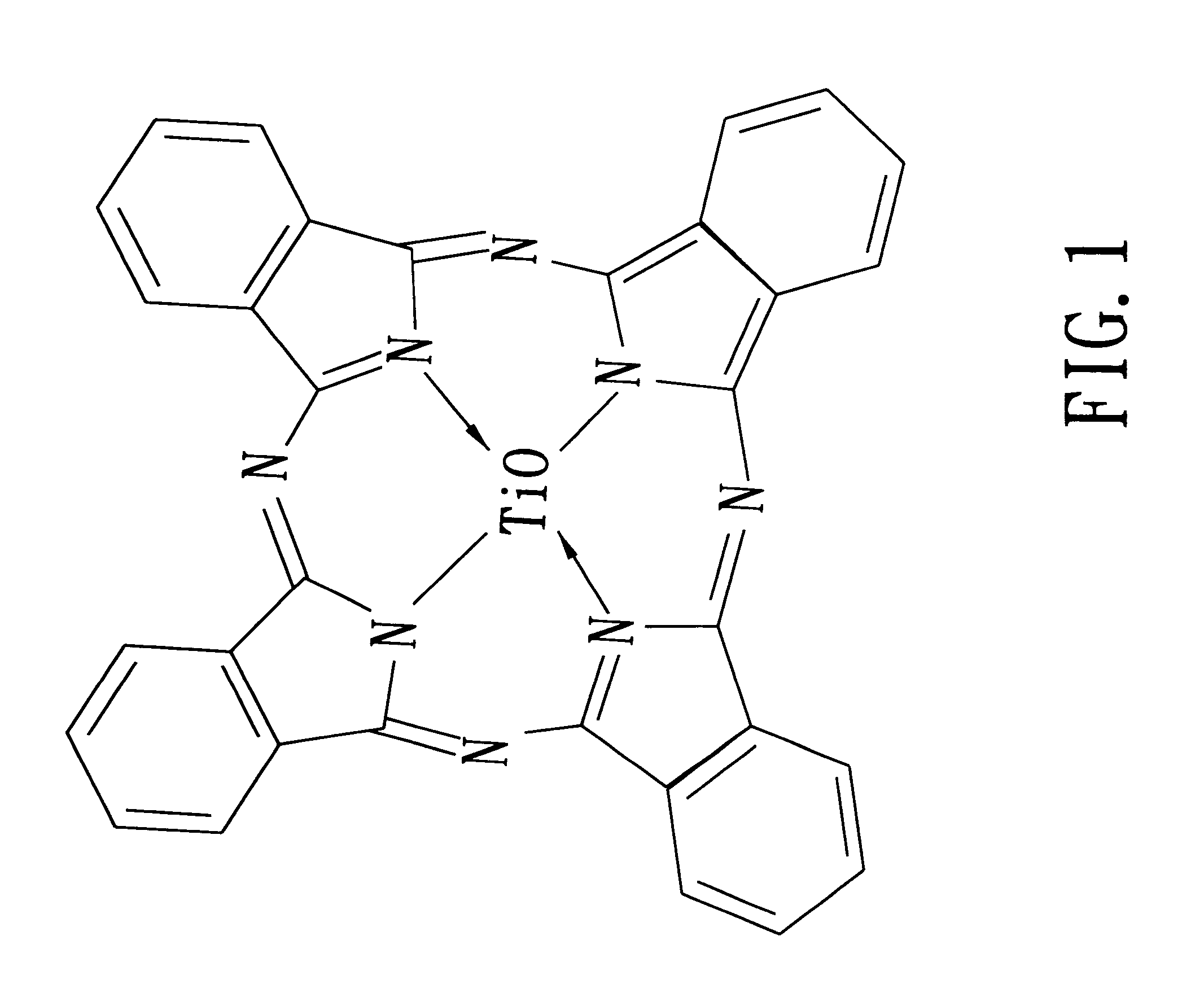Titanyl phthalocyanine, method for production thereof and electrophotographic photoreceptor containing the same
a technology of titanyl phthalocyanine and electrophotographic photoreceptor, which is applied in the field of titanyl phthalocyanine, can solve the problems of high production cost, inability to neglect the possibility of water doping on the titanyl phthalocyanine molecule, and several major drawbacks of inorganic photoconductive materials
- Summary
- Abstract
- Description
- Claims
- Application Information
AI Technical Summary
Benefits of technology
Problems solved by technology
Method used
Image
Examples
example 1
To a 500 millimeter reactor container with divided chambers is added 250 millimeter anhydrous hydrogen peroxide and chlorobenzene solution prepared by Example 1, followed by mechanically stirring and then refrigerated remaining at -10.degree. C. in one chamber. Next, the low crystalline titanyl phthalocyanine treated by methanol is gradually added in a mole ratio of hydrogen peroxide to titanyl phthalocyanine controlled as 1:25, followed by successively stirring for 5 hrs, and then filtered for washing by chlorobenzene twice. refined titanyl phthalocyanine.
FIG. 6 shows the X-ray diffraction pattern of the refined titanyl phthalocyanine which has Bragg diffraction angles (2.theta..+-.0.2.degree. ) of 7.3, 9.4, 14.0, 24.1, 25.7, 27.2 and 28.5 degrees. The XRPD pattern represents a unique crystal form compared to those disclosed in the various prior art patent documents such as U.S. Pat. No. 5,298,617 or U.S. Pat. No. 5,567,559. The FTIR spectrum of the refined titanyl phthalocyanine i...
example 2
In this Example, it is substituted for 250 g of anhydrous hydrogen peroxide and chlorobenzene solution prepared by Example 2 and the mole ratio of hydrogen peroxide to titanyl phthalocyanine controlled as 1:8.7. It is the same that electrophotographic properties of the photoreceptor containing the refined titanyl phthalocyanine is determined by the phothconductivity measuring device. The results are also listed in Table 1.
example 3
20 g of the low crystalline titanyl phthalocyanine methanol is gradually added after 300 g of chlorobenzene and 30 g of 10% hydrogen peroxide solution is added in the reactor container with divided chambers, followed by mechanically stirring and then refrigerated remaining at -10.degree. C. in one chamber. Next, the solution is successively stirred for 6 hrs and filtered for washing by chlorobenzene and water once respectively. Finally, the titanyl phthalocyanine product is dried at 70.degree. C. under vacuum overnight to obtain 18.5 g of refined titanyl phthalocyanine.
FIG. 7 shows the X-ray diffraction pattern of the refined titanyl phthalocyanine which has Bragg diffraction angles (2.theta..+-.0.2.degree. ) of 7.3, 9.4, 14.0, 24.1, 25.7, 27.2 and 28.5 degrees. The XRPD pattern represents a unique crystal form compared to those disclosed in the various prior art patent documents.
The refined titanyl phthalocyanine use the same procedure as mentioned above to afford the coating solut...
PUM
 Login to View More
Login to View More Abstract
Description
Claims
Application Information
 Login to View More
Login to View More - R&D
- Intellectual Property
- Life Sciences
- Materials
- Tech Scout
- Unparalleled Data Quality
- Higher Quality Content
- 60% Fewer Hallucinations
Browse by: Latest US Patents, China's latest patents, Technical Efficacy Thesaurus, Application Domain, Technology Topic, Popular Technical Reports.
© 2025 PatSnap. All rights reserved.Legal|Privacy policy|Modern Slavery Act Transparency Statement|Sitemap|About US| Contact US: help@patsnap.com



